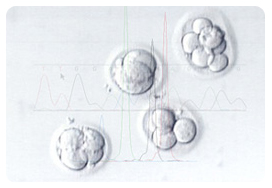
PGD of single gene disorders, combined with HLA matching, represents one of the most recent applications in reproductive medicine. This strategy has emerged as a tool for couples at risk of transmitting a genetic disease to select unaffected embryos of a Human Leukocyte Antigen (HLA) tissue type compatible with those of an existing affected child. In such cases, PGD is used not only to avoid the birth of affected children, but also to conceive healthy children who may also be potential HLA-identical donors of haematopoietic stem cells (HSC) for transplantation in siblings with a life-threatening disorder. At delivery, HSC from the newborn umbilical cord blood are collected and used for the haematopoietic reconstruction of the affected sibling, that without stem cell transplant is likely to die.
At present, allogenic HSC transplantation represents the only curative treatment for restoring normal hematopoiesis in severe cases of neoplastic (eg. Leukaemia) or congenital (eg. β-thalassemia) disorders affecting the haematopoietic and/or the immune system. A critical factor associated with favorable outcome in stem cell transplantation is the use of HLA-genotype identical donors, and HLA identical siblings provide the best chance to the recipient in the achievement of a successful transplantation. Unfortunately, because of the limited availability of HLA-matched sibling donors, most of the patients face the option of transplantation using a volunteer unrelated matched donor, identified from national or international registers. Although, in these cases, the results are less favorable compared to the matched-sibling transplant and are associated with a higher morbidity and poorer survival.
Umbilical cord blood (UCB) represents an attractive alternative source of stem cells, providing a potential expansion of the donor pool to patients without a suitable family match, thus increasing the likelihood to find a compatible matched donor for any particular patient. UCB is collected from an otherwise discarded placenta and can be harvested with no risk to the newborn donor.
Transplantation using UCB stem cells provides better reconstitution of hematopoiesis, compared with bone marrow transplantation and also produce less severe transplant-related complications. The overall success rate of HSC transplants is mainly related to the degree of HLA compatibility between donor and recipient. HLA mismatches are increased using unrelated donors, with a consequent higher incidence of both transplant-related mortality and graft-versus-host disease.
For Thalassemia, when an HLA identical sibling marrow donor is available, the chance of cure is currently over 90%. Allogeneic HSC transplantation from alternative donors or donor sources has been succesfully applied in patients with beta-thalassemia (Gaziev 2000, Locatelli 2003) but is less favorable as compared to those with an HLA identical donor. In general, the disease free survival after HLA matched CBT in the case of a genetic disease (Locatelli 2003) and severe aplastic anemia (Barker 2001) is high (90%), whereas in the case of a acquired disease such as leukemia it is much lower (50%)(Eapen 2006) because here the patient also has to be cured from the tumour.
Therefore, if no HLA identical donor is available in the family, an increasing number of couples with a child affected by an haematopoietic disorder are considering the use of IVF and PGD techniques for therapeutic intent, to conceive a healthy child who could become a future donor of HSC to be used for the haematopoietic reconstruction of the existing affected sibling.